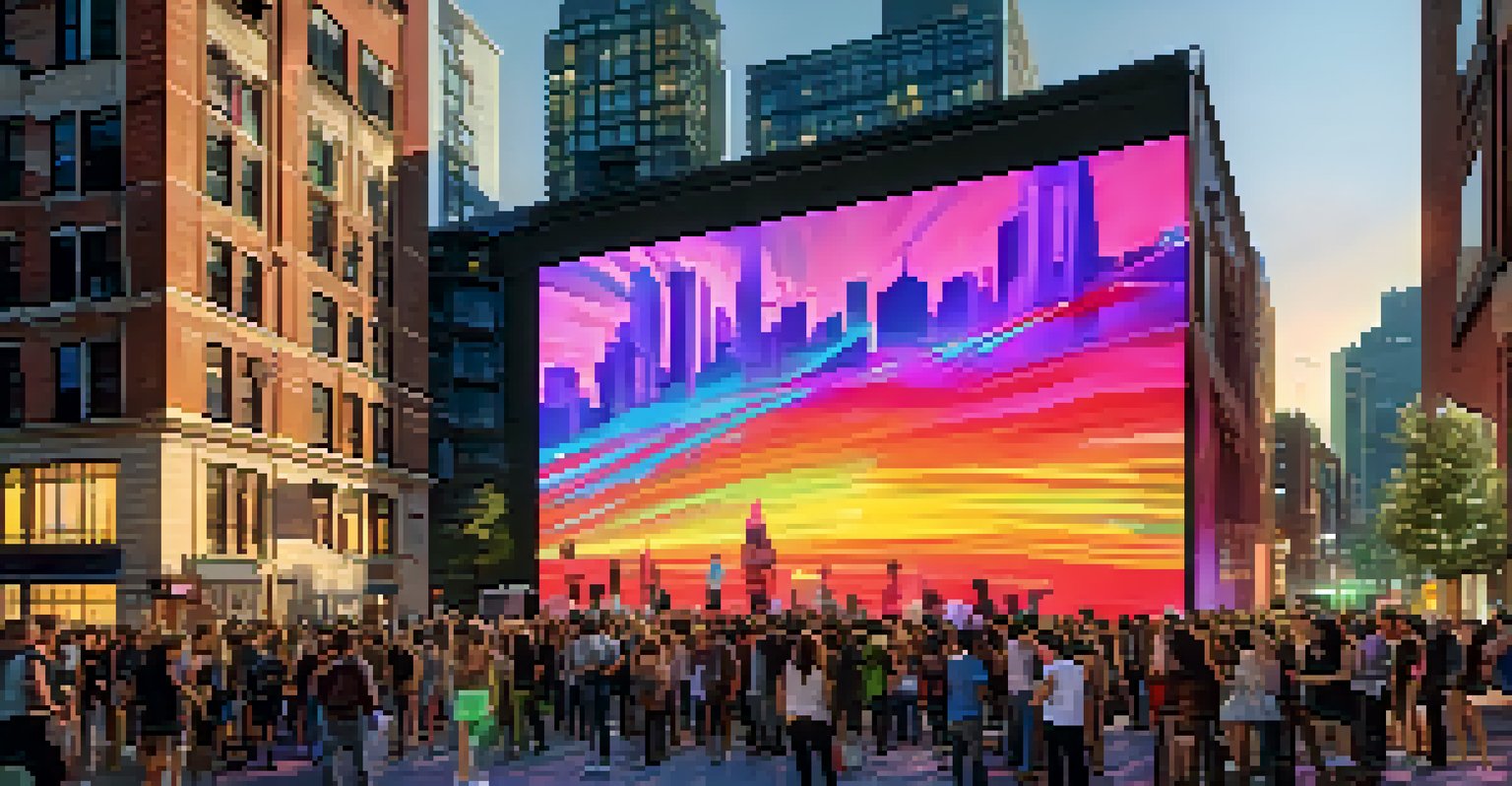The Influence of Digital Art on Modern Civic Identity

Understanding Civic Identity in a Digital Age
Civic identity refers to how individuals perceive their roles and responsibilities within a community. In our increasingly digital world, this identity is evolving rapidly as we engage with technology and digital platforms. The rise of social media and online forums allows people to connect in ways that transcend geographical boundaries, creating a more global sense of community.
Art is a way of recognizing ourselves and each other in the world, and it is a powerful means of expressing our civic identity.
As we interact in these virtual spaces, digital art serves as a powerful medium for self-expression and community storytelling. Artists utilize various online platforms to share their work, which often reflects local issues or cultural narratives, thereby fostering a deeper connection with their civic identity. This blend of art and technology encourages individuals to explore and redefine what it means to be a part of a civic community.
Moreover, the accessibility of digital art enables diverse voices to be heard, which is crucial for a healthy civic identity. When marginalized groups create and share their art online, they challenge dominant narratives and bring attention to their unique experiences. This not only enriches the cultural tapestry of a community but also empowers individuals to engage more actively in civic matters.
Digital Art as a Tool for Civic Engagement
Digital art has emerged as an innovative tool for civic engagement, encouraging individuals to participate in discussions and movements. Artists often use their platforms to raise awareness about social issues, prompting viewers to reflect on their own civic responsibilities. This art becomes a rallying point, inspiring communities to come together for a common cause.

For example, public art installations and digital murals can transform urban spaces into vibrant platforms for dialogue. These artworks not only beautify the environment but also provoke thought and conversation around civic issues, such as inequality and environmental sustainability. By engaging with these pieces, community members are encouraged to consider their roles in addressing these challenges.
Digital Art Enhances Civic Identity
Digital art fosters community engagement and self-expression, allowing individuals to connect with their civic responsibilities through creative platforms.
In addition, social media campaigns that incorporate digital art often go viral, spreading messages quickly and effectively. This ability to reach a broad audience amplifies the impact of civic messages, making digital art a formidable force in shaping public opinion and mobilizing action. As a result, artists become vital contributors to the civic landscape, influencing both policy and public consciousness.
The Role of Community in Digital Art Creation
Community plays a crucial role in the creation and appreciation of digital art. Collaborative projects, such as community mural initiatives or online art challenges, invite participants to contribute their perspectives and stories. This collective process not only enriches the artwork but also strengthens community bonds, as individuals come together to share their experiences and ideas.
Digital art can serve as a bridge to community engagement, transforming personal stories into collective experiences that foster civic pride.
Furthermore, local artists often draw inspiration from their surroundings and the people within them. Their work reflects the collective identity of the community, capturing its unique spirit and challenges. By showcasing their art in public spaces or online platforms, these artists foster a sense of pride and belonging among residents.
As digital art continues to evolve, the importance of community involvement remains paramount. Engaging with local stakeholders ensures that the art produced resonates with the values and needs of the community. This collaborative approach not only enhances the artwork's relevance but also empowers citizens to take an active role in shaping their civic identity.
Challenges Facing Digital Artists in Civic Spaces
Despite its potential, digital art in civic spaces faces several challenges that can hinder its effectiveness. One significant issue is the digital divide, where access to technology is not evenly distributed across communities. This gap can limit who gets to participate in the creation and appreciation of digital art, resulting in a less inclusive civic identity.
Additionally, digital artists often grapple with issues of copyright and ownership in an online environment. As their work is shared and remixed across platforms, maintaining control over their original pieces becomes increasingly complex. This raises questions about the value of their contributions and how they can receive recognition for their efforts.
Community Collaboration is Key
The involvement of local communities in digital art initiatives strengthens bonds and ensures that the artwork reflects shared values and narratives.
Moreover, the ephemeral nature of digital art means that it can be easily forgotten or overlooked in the fast-paced digital landscape. Artists must continually innovate and adapt to keep their work relevant, which can be a daunting task. Addressing these challenges is essential for ensuring that digital art remains a vibrant and impactful component of modern civic identity.
Case Studies: Successful Digital Art Initiatives
Several successful initiatives demonstrate the power of digital art in enhancing civic identity. One notable example is the 'Humans of New York' project, which combines photography with storytelling to highlight the lives of everyday New Yorkers. This initiative fosters a sense of community by showcasing diverse narratives and encouraging empathy among residents.
Another example is the 'We the People' campaign, which invites digital artists to create artwork representing civic issues. By involving artists from various backgrounds, the campaign amplifies underrepresented voices and stimulates dialogue around critical topics. Such initiatives not only engage the community but also inspire collective action toward positive change.
These case studies illustrate how digital art can effectively engage and empower communities. By connecting individuals through shared experiences and creative expression, these initiatives contribute to a richer, more inclusive civic identity that resonates with a wider audience.
The Future of Digital Art and Civic Identity
As technology continues to evolve, the future of digital art is closely tied to the development of civic identity. Innovations such as augmented reality (AR) and virtual reality (VR) are opening new avenues for artistic expression and community engagement. These technologies can transform public spaces into immersive experiences, allowing citizens to interact with digital art in novel ways.
Furthermore, the rise of blockchain technology offers new possibilities for artists to maintain ownership of their work while ensuring fair compensation. This could empower more creators to participate in civic art projects, enriching the cultural landscape and encouraging broader community involvement. As artists explore these emerging technologies, the integration of digital art into civic identity will likely deepen.
Challenges for Digital Artists Persist
Digital artists face hurdles like the digital divide and copyright issues that can limit their ability to effectively contribute to civic discourse.
Ultimately, the future holds immense potential for digital art to enhance civic identity through creativity, collaboration, and innovation. As communities continue to adapt to the digital age, embracing the contributions of artists will be vital in shaping a vibrant and inclusive civic discourse.
Conclusion: Embracing Digital Art for Civic Growth
In conclusion, the influence of digital art on modern civic identity is profound and multifaceted. It serves as a catalyst for engagement, encouraging individuals to reflect on their roles within their communities while promoting diverse voices. As we continue to navigate the complexities of the digital age, the importance of fostering inclusive artistic expression cannot be overstated.
By supporting digital artists and their initiatives, we can enrich our civic landscapes and cultivate a sense of belonging among residents. The collaboration between artists and communities is essential in ensuring that digital art reflects the values and needs of the people it represents. This symbiotic relationship will ultimately lead to a more vibrant and engaged civic identity.

As we look to the future, embracing the potential of digital art will be crucial for fostering community growth and resilience. By harnessing the power of creativity, we can inspire meaningful change and strengthen the bonds that unite us as citizens.